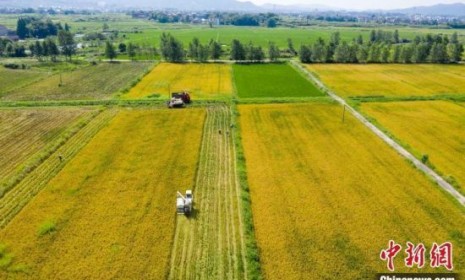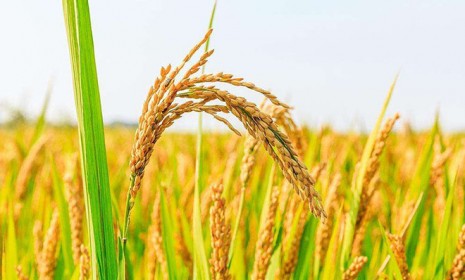近日,華中農業大學棉花遺傳改良團隊發表關于攻克棉花抗枯萎病分子育種技術瓶頸的研究成果,研究首次鑒定到了陸地棉抗枯萎病主效基因Fov7,并首次發現谷氨酸類受體(GLUTAMATE RECEPTOR-LIKE,GLR)可作為非典型主效抗病基因調控植物免疫反應。
尖孢鐮刀菌(Fusarium oxysporum)是一種廣泛存在的土傳病原真菌,其寄主范圍廣泛,可侵染包括茄科蔬菜、瓜類、棉花、香蕉及花卉等100多種具有重要經濟價值的植物,位列全球十大病原真菌第五位,對全球農作物健康生產危害嚴重。棉花枯萎病(Fusarium wilt)是由尖孢鐮刀菌萎蔫專化型(Fusarium oxysporum f.sp. vasinfectum (Fov) Atk. Sny & Hans)引起的真菌病害,是世界棉花生產過程中危害最嚴重的病害之一,與黃萎病并稱為棉花的“癌癥”。目前世界范圍內已鑒定到8個生理小種,其中7號生理小種在我國分布最為廣泛且致病力最強,是影響我國棉花生產的優勢小種。陸地棉抗枯萎病的主效基因及其介導的抗病機制長期未知影響了棉花抗枯萎病育種效率。
研究利用290份陸地棉栽培種組成的自然群體經過多年新疆田間鑒定,結合覆蓋全基因組的高密度SNP標記對棉花枯萎病抗性進行了全基因組關聯分析,鑒定到棉花抗枯萎病菌7號生理小種的主效抗病位點Fov7,并對Fov7的候選基因進行了驗證和功能分析。研究發現Fov7定位在D03染色體1.97-2.37 Mb,該區間包含23個候選基因。進一步分析表明顯著性最高的SNP位點位于一個編碼谷氨酸類受體(GLR)基因Gh_D03G0209的編碼區,導致該基因胞外結構域一個氨基酸變異。蛋白序列的進化分析表明陸地棉具有不同于擬南芥GLR三個家族的第四個亞家族GLR4,Gh_D03G0209屬于第四亞家族成員,并將其命名為GhGLR4.8。
研究發現,在高抗枯萎病的棉花品種中抑制GhGLR4.8的表達或通過基因編輯突變GhGLR4.8都使得棉花品種變得極為感病。根據GhGLR4.8在抗病和感病品種中等位基因的SNP變異開發了基于PCR擴增的分子標記,并建立了可區別GhGLR4.8抗病基因型和感病基因型的檢測體系。通過人工分離群體證明該標記與棉花抗枯萎病共分離,可實現棉花抗枯萎病種質資源的快速篩選與鑒定。以上研究證明,棉花抗枯萎病主效基因Fov7編碼谷氨酸類受體(GLR),是一種新的植物非典型主效抗病基因。
本研究完善了植物與病原菌分子互作理論體系,為棉花抗枯萎病分子育種提供了技術支撐,并對棉花抗黃萎病研究提供了借鑒。
【英文摘要】
Fusarium wilt (FW) disease of cotton, caused by the fungus Fusarium oxysporum f. sp. vasinfectum (Fov), causes severe losses in cotton production worldwide. Though significant advancements have been made in development of FW‐resistant Upland cotton (Gossypium hirsutum) in resistance screening programs, the precise resistance genes and the corresponding molecular mechanisms for resistance to Fov remain unclear. Herein it is reported that Fov7, a gene unlike canonical plant disease‐resistance (R) genes, putatively encoding a GLUTAMATE RECEPTOR‐LIKE (GLR) protein, confers resistance to Fov race 7 in Upland cotton. A single nucleotide polymorphism (SNP) (C/A) in GhGLR4.8, resulting in an amino acid change (L/I), is associated with Fov resistance. A PCR‐based DNA marker (GhGLR4.8SNP(A/C)) is developed and shown to cosegregate with the Fov resistance. CRISPR/Cas9‐mediated knockout of Fov7 results in cotton lines extremely susceptible to Fov race 7 with a loss of the ability to induce calcium influx in response to total secreted proteins (SEPs) of Fov. Furthermore, coinfiltration of SEPs with GhGLR4.8A results in a hypersensitive response. This first report of a GLR‐encoding gene that functions as an R gene provides a new insight into plant–pathogen interactions and a new handle to develop cotton cultivars with resistance to Fov race 7.
論文鏈接:https://onlinelibrary.wiley.com/doi/full/10.1002/advs.202002723
日期:2021-02-22
尖孢鐮刀菌(Fusarium oxysporum)是一種廣泛存在的土傳病原真菌,其寄主范圍廣泛,可侵染包括茄科蔬菜、瓜類、棉花、香蕉及花卉等100多種具有重要經濟價值的植物,位列全球十大病原真菌第五位,對全球農作物健康生產危害嚴重。棉花枯萎病(Fusarium wilt)是由尖孢鐮刀菌萎蔫專化型(Fusarium oxysporum f.sp. vasinfectum (Fov) Atk. Sny & Hans)引起的真菌病害,是世界棉花生產過程中危害最嚴重的病害之一,與黃萎病并稱為棉花的“癌癥”。目前世界范圍內已鑒定到8個生理小種,其中7號生理小種在我國分布最為廣泛且致病力最強,是影響我國棉花生產的優勢小種。陸地棉抗枯萎病的主效基因及其介導的抗病機制長期未知影響了棉花抗枯萎病育種效率。
研究利用290份陸地棉栽培種組成的自然群體經過多年新疆田間鑒定,結合覆蓋全基因組的高密度SNP標記對棉花枯萎病抗性進行了全基因組關聯分析,鑒定到棉花抗枯萎病菌7號生理小種的主效抗病位點Fov7,并對Fov7的候選基因進行了驗證和功能分析。研究發現Fov7定位在D03染色體1.97-2.37 Mb,該區間包含23個候選基因。進一步分析表明顯著性最高的SNP位點位于一個編碼谷氨酸類受體(GLR)基因Gh_D03G0209的編碼區,導致該基因胞外結構域一個氨基酸變異。蛋白序列的進化分析表明陸地棉具有不同于擬南芥GLR三個家族的第四個亞家族GLR4,Gh_D03G0209屬于第四亞家族成員,并將其命名為GhGLR4.8。
研究發現,在高抗枯萎病的棉花品種中抑制GhGLR4.8的表達或通過基因編輯突變GhGLR4.8都使得棉花品種變得極為感病。根據GhGLR4.8在抗病和感病品種中等位基因的SNP變異開發了基于PCR擴增的分子標記,并建立了可區別GhGLR4.8抗病基因型和感病基因型的檢測體系。通過人工分離群體證明該標記與棉花抗枯萎病共分離,可實現棉花抗枯萎病種質資源的快速篩選與鑒定。以上研究證明,棉花抗枯萎病主效基因Fov7編碼谷氨酸類受體(GLR),是一種新的植物非典型主效抗病基因。
本研究完善了植物與病原菌分子互作理論體系,為棉花抗枯萎病分子育種提供了技術支撐,并對棉花抗黃萎病研究提供了借鑒。
【英文摘要】
Fusarium wilt (FW) disease of cotton, caused by the fungus Fusarium oxysporum f. sp. vasinfectum (Fov), causes severe losses in cotton production worldwide. Though significant advancements have been made in development of FW‐resistant Upland cotton (Gossypium hirsutum) in resistance screening programs, the precise resistance genes and the corresponding molecular mechanisms for resistance to Fov remain unclear. Herein it is reported that Fov7, a gene unlike canonical plant disease‐resistance (R) genes, putatively encoding a GLUTAMATE RECEPTOR‐LIKE (GLR) protein, confers resistance to Fov race 7 in Upland cotton. A single nucleotide polymorphism (SNP) (C/A) in GhGLR4.8, resulting in an amino acid change (L/I), is associated with Fov resistance. A PCR‐based DNA marker (GhGLR4.8SNP(A/C)) is developed and shown to cosegregate with the Fov resistance. CRISPR/Cas9‐mediated knockout of Fov7 results in cotton lines extremely susceptible to Fov race 7 with a loss of the ability to induce calcium influx in response to total secreted proteins (SEPs) of Fov. Furthermore, coinfiltration of SEPs with GhGLR4.8A results in a hypersensitive response. This first report of a GLR‐encoding gene that functions as an R gene provides a new insight into plant–pathogen interactions and a new handle to develop cotton cultivars with resistance to Fov race 7.
論文鏈接:https://onlinelibrary.wiley.com/doi/full/10.1002/advs.202002723
日期:2021-02-22















